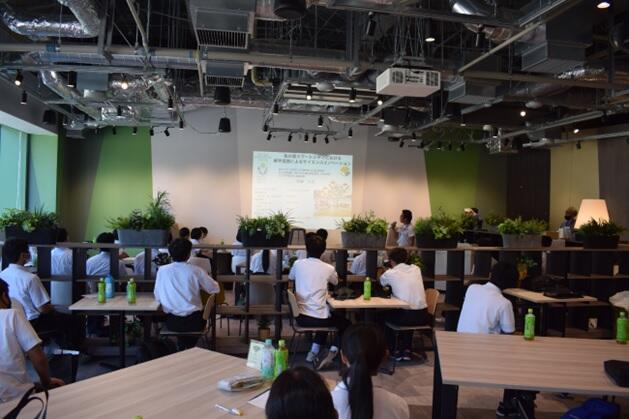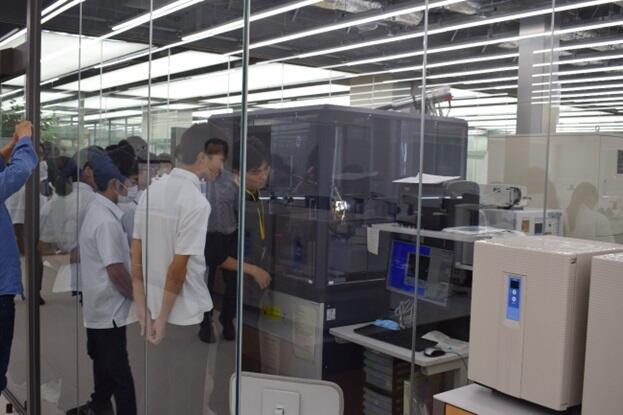The nuclear magnetic resonance equipment (NMR), X-ray diffractometers (XRD), and mass spectrometers (MS) are among the essential items required for molecular structure analysis. Researchers integrate the different data gathered with these items made by different manufactures when they undertake analyses.
FSCreation is on the top floor of Mitsui LINK-Lab Kashiwanoha 1 (Kashiwa City, Chiba Prefecture) where Distinguished Professor Makoto Fujita and Project Professor Sota Sato, from The University of Tokyo, have their laboratories. Shimadzu Corporation, JEOL Ltd., and Rigaku Corporation also have their NMR, XRD, and MS equipment here, along with the resident researchers from each company. These members provide support for molecular structure analysis. This is a one-stop open platform for industry-academia collaboration that offers solutions to various problems brought in from the private sector or academia. A large number of joint research initiatives are already in progress, yielding a variety of results.
More than forty first and second years from Miyazaki-Nishi High School, Miyazaki Prefecture, visited FSCreation, the open innovation base at the state-of-the-art level of life science, to experience XRD for their practice. FSCreation has been welcoming tours, but that was its first attempt to use the real equipment for training high school students.

In the cafe space of LINK-Lab, Sato introduced himself and explained the significance of molecular structure analysis in the field of organic chemistry. He also shared the enthusiasm for their research and discussed the projects at FSCreation. He also mentioned Fujita's research, saying, "X-ray structural analysis requires crystallization of the object, but this process is very difficult. Since we cannot explain why the object cannot be crystallized, we feel like we are facing a "probatio diabolica" (impossible proof) problem. Universities, colleges, laboratories, companies, and everybody in the world have been troubled by this. In 2013, Professor Fujita discovered that if a crystalline sponge is made to absorb the molecules that do not crystallize, they can be treated like crystals. Subsequently, X-ray can be used to identify their structures."
Shimadzu Corporation contributed through the use of LCMS to molecular structure analysis, JEOL Ltd. through NMR in molecular structure analysis, and Rigaku Corporation through the use of X-ray diffraction in molecular structure analysis as well as the basics of X-ray diffraction. Next, the visitors were divided into three groups for observing the crystallization under an optical microscope and for observing real crystals under an XRD equipment. The high school students cheered when they succeeded in analyzing the structure of glutamic acid crystals that they had brought with them, in addition to sugar crystals that Link-Lab had prepared for them.
It is difficult to operate XRD equipment, and the equipment is very expensive. This means that, generally speaking, high school students would never have a chance to use a real machine for their training. However, Sato said, "It is not much fun to visit just for sightseeing and to listen to stories. I wanted them to experience the real thing in their experiments. They might not be very impressed just by the results of some experiments using an MMR or a mass spectrometer. As for an X-ray diffractometer, the students can use the mouse to rotate the three-dimensional structure of molecules. I figured this might be exciting, but I was a little worried that it might be difficult. However, we did it anyway without any rehearsal. We may rethink our tour course to include some training if the session this time is rated highly.

Toshiya Nasu, a teacher from Miyazaki-Nishi High School noted, "Students with strong academic records often gravitate toward clinical careers because they can easily envision them. However, we also aim to spark their interest in the field of research, which presents one of our challenges in career guidance. The challenge we face is, being located in Miyazaki Prefecture, many of our students struggle to envision what being a researcher and research actually entails.
We requested one of our graduates, who worked under Professor Sato, to help us. Last year, amidst the influence of the coronavirus, we invited Professor Sato to deliver his lecture at our location. However, this time, many of our students expressed a strong desire to experience it in person and so we made the necessary arrangements to accommodate their request. They graciously presented us with an opportunity to witness a world-class experience. As a high school, we have the privilege of taking our students to places that their parents might not have the chance to. Furthermore, it was an excellent experience that the experts from the manufacturers talked to our students. I hope this project may motivate our students to become a researcher--even if it will be just ten of them."
This article has been translated by JST with permission from The Science News Ltd. (https://sci-news.co.jp/). Unauthorized reproduction of the article and photographs is prohibited.




